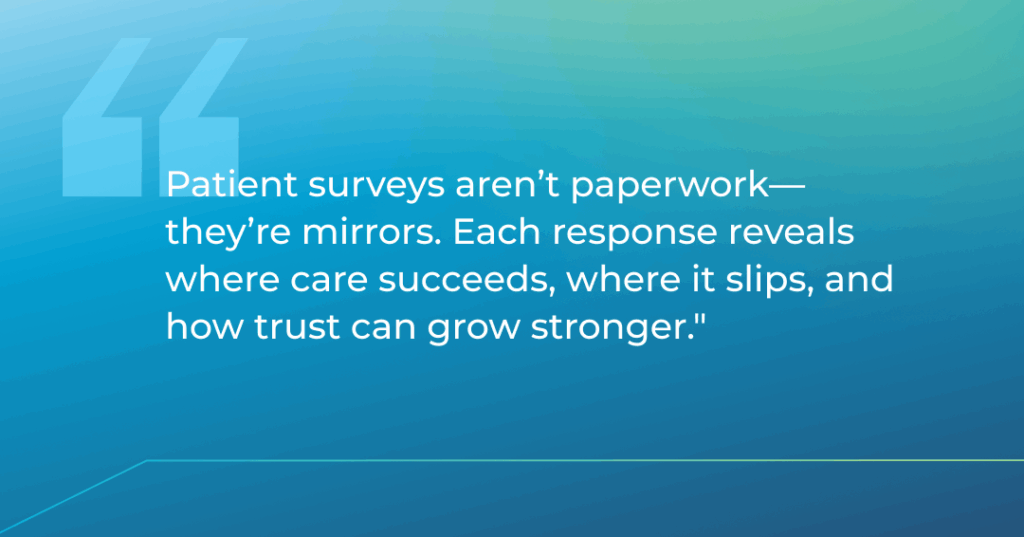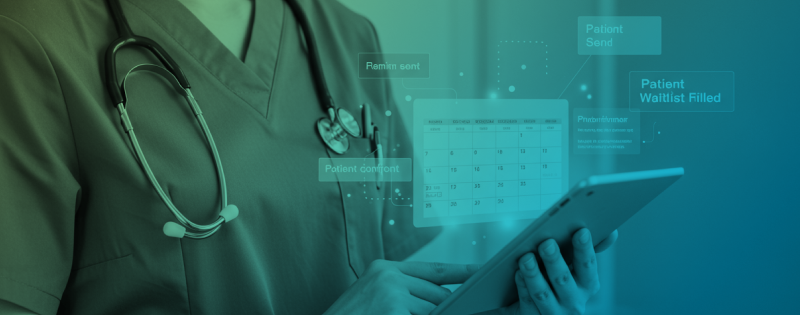Last flu season claimed the lives of more than 200 children in the United States,…

How to Use Patient Satisfaction Surveys to Boost Care Quality
Your patients’ feedback goes far beyond collecting just opinions and sentiments. It’s hard data that shows you exactly where service gaps are appearing and what changes need to be made.
Considering how the health sector lies on a foundation of trust and transparency, it’s not difficult to understand why (and how) surveys are the driving force behind successful healthcare organizations.
What’s a Patient Satisfaction Survey?
Patient satisfaction surveys are one of the primary means by which healthcare providers receive feedback about their services. They ask about patient experience, ranging from the ability of the doctors to whether the place was clean and hospitable.
These surveys are supposed to be brief and often follow a standard template, but are not supposed to limit you in case you want to cover areas unique to your practice.
Why Patient Satisfaction Surveys Matter in Healthcare
Healthcare organizations depend on patient surveys to improve their services. You’re directly asking patients to report problems they faced or services they feel could be further improved. This feedback helps you spot patterns for targeted efforts instead of guessing what’s wrong, saving both time and money.
It should also be noted that most patients don’t feel like reporting issues. They just endure poor customer service, for example, and consider going elsewhere for their care the next time. These cases are not isolated and tend to stack up over time.
When you start asking them at every point to rate their patient satisfaction, and actually act upon their given feedback, they’re more likely to return for follow-ups and recommend you to their friends and family.
And if surveys indicate that patients enjoyed particular doctors or nurses, it encourages their efforts and boosts the entire team.
Common Types of Patient Satisfaction Surveys
There are different patient satisfaction survey formats for different care settings and touchpoints. Each type (below) serves a specific purpose, depending on the goals of the provider.
Practice-Level Surveys
These questionnaires ask about the convenience of scheduling appointments, waiting time, patient interactions with staff, hygiene, etc. Most offices mail them out on the same day via text message or email in an effort to obtain immediate feedback while patients still remember details of what they experienced.
Hospital-Wide Surveys (HCAHPS)
The HCAHPS survey is a standardized questionnaire administered within a month after discharge to a random sample of adult patients. It can be conducted by mail, telephone, mail with telephone follow-up, or chatbots.
The questions focus on caregiver communication and responsiveness, hospital cleanliness, and discharge preparations, reflecting patients’ assessment of their hospital care.
Hospitals must use HCAHPS public benchmarking. It allows patients to compare hospitals based on consistent metrics across different facilities.
Post-Visit Feedback Surveys
Most of these surveys only take a couple of minutes, and providers usually send them out shortly after the visit while the experience is still fresh. They focus on specific interactions, like whether the provider explained treatment options clearly or if the patient felt listened to. Getting feedback this quickly gives clinics a chance to step in and fix issues right away.
Survey Based on Communication Channels
Different delivery methods affect patient engagement and response rates significantly. SMS surveys typically achieve higher response rates among younger patients, while email works better for older demographics.
Phone surveys tend to produce the most feedback but are more expensive to administer. In addition, waiting-area-based kiosks are very effective at gathering feedback from patients who will not respond to follow-up contact.
Telehealth Surveys
What’s the point of a digital consultation if you can’t see or hear the doctor clearly? These surveys address those technical details, confirming whether patients felt the online visit met their needs.
Pharmacy Satisfaction Surveys
These surveys often ask whether pharmacy staff explained potential side effects, drug interactions, and proper usage instructions clearly.
Many pharmacy chains send these surveys via text message or email after prescription pickups. It helps pharmacies identify staffing issues during peak hours and improve patient education processes.
What Questions Should You Ask in Your Patient Satisfaction Survey?
The questions you ask in your patient satisfaction survey make all the difference between getting useful feedback and collecting useless data. Good questions tell you exactly what’s working and what’s broken in your practice. The examples below come from top-performing healthcare organizations and proven survey frameworks.
Core Experience Questions
Start with the basics that every patient notices, like wait times and how smoothly the visit went.
- “How long did you wait to see your doctor?” (Much shorter than expected → Much longer than expected)
- “How helpful was our front desk staff when you checked in and out?” (Very helpful → Not helpful at all)
Questions Related to Provider Communication
Find out if your doctors and nurses actually connect with patients or just rush through each appointment.
- “Did your doctor explain your condition and treatment in a way that made sense to you?” (Yes/No with rating scale)
- “How well did your doctor listen to what you had to say?” (Listened carefully → Didn’t listen at all)
Questions About Facility & Environment
Even before they’ve met their doctors, patients are most likely to consider how clean your facility is. Your building and equipment matter more than you might think for patient comfort and confidence.
- “How clean did our facility look during your visit?” (Very clean → Very dirty)
- “Could you easily find where you needed to go in our building?” (Very easy → Very difficult)
Outcomes & Follow-Up Questions
Care doesn’t stop the day a patient goes home. It’s important to see if they feel good about their treatment and know what comes next.
- “How confident are you in your doctor’s treatment plan?” (Very confident → Not confident at all)
- “Did we clearly explain what you need to do for follow-up care?” (Yes/No, with rating)
Open-Ended Questions for Overall Improvements
There might be an area you forgot to cover or a patient’s issue that doesn’t fall under any survey type. Let them speak their minds here.
- “What’s one thing we could do better to improve your experience here?”
- “Is there anything else about your visit you’d like us to know?”
Ease of Access to Care
It’s important to know whether patients can actually get care when they need it.
- “How easy was it for you to schedule an appointment?” (Very easy → Very difficult)
- “Does your doctor respond to your after-hours health questions?” (Very satisfied → Very dissatisfied)
Digital Experience & Communication
Many patients expect to take care of health tasks online, so it helps to check how well your digital tools are working.
- “If you used our patient portal or website to book an appointment, how was that experience?” (Excellent → Poor)
- “How would you prefer we contact you with reminders and results?” (Phone, text, email, patient portal)
Questions Related to Cultural Sensitivity and Inclusiveness
Every patient should feel respected and included, no matter their background.
- “Did our staff treat you with respect throughout your visit?” (Always → Never)
- “Did you feel comfortable discussing your health concerns with your care team?” (Very comfortable → Very uncomfortable)
Creating an Effective Patient Satisfaction Survey for the Right Results
Gathering honest feedback from patients isn’t as simple as asking them open-ended questions. You don’t want their opinions. You want actionable insights that impact how you deliver care. Here’s how to create patient satisfaction surveys that actually work.

Define Your Goal
Decide what you’re trying to learn before coming up with your questions. If you’re wondering about how good your communication is, ask how well the doctors addressed concerns during visits. If you’re wondering about your scheduling process, ask how easy it was to book an appointment.
Narrowing down your goals is important because trying to measure everything at once creates confusion and lowers response rates.
Choose the Right Patient Segment to Target
Demographics matter because different patients face different challenges. New patients focus on access and scheduling, while established patients care more about continuity and relationship quality. Sending the wrong questions will only lower your response rates.
Choose the Right Time for the Survey Based on Objectives
Your surveys are only effective if they are sent at the right time. Consider this: patients who are in the middle of their visit can’t help if you start asking them about their experience early on. However, in other cases, wait too long and they’ve likely forgotten important details.
For outpatients, 24-48 hours is optimal. Patients recall their visit well, but aren’t coping with post-appointment tasks. For inpatient stays, wait 3-5 days to allow patients to get established in their homes.
Keep the Survey Concise and Focused
We’ve already pointed out the importance of keeping your surveys focused on what you’re trying to learn. It’s also equally important not to go overboard by asking too many questions.
As a rule of thumb, every extra question costs your responses. Patients are likely to answer 5-7 questions at best before abandoning the survey. So, if you’re measuring communication, skip questions about parking and billing.
Use Clear, Neutral, and Patient-Friendly Language
Most providers make the mistake of using too much clinical terminology or too complicated sentences.
Ask “How well did your nurse explain your medications?” instead of “Rate the effectiveness of pharmaceutical education delivery.” The first version gets better responses because patients understand exactly what you’re asking.
Watch out for leading questions. “How satisfied were you with our excellent care?” pushes patients toward positive responses. “How would you rate the care you received?” lets them answer honestly.
Also, keep rating scales consistent throughout your survey. Five-point scales work well because patients understand them intuitively. Don’t mix 5-point and 10-point scales in the same survey. It confuses respondents.
Select the Right Distribution Channels
Every type of survey garners the most responses if sent through the most appropriate channel. For instance, email surveys work well for routine follow-ups. They are also convenient for patients. Text messages are convenient as well and actually get higher response rates, but they limit your ability to ask longer, complicated questions.
Phone calls, on the other hand, work great for older patients, while patient portals are best for active users.
Ensure Privacy, Security, and HIPAA Compliance
Patients won’t share freely if they feel their feedback could come back to them. You remove that hesitation by telling them upfront how you’re safeguarding their information through secure systems and strict HIPAA compliance. Hence, providers gain insights that reflect what’s really happening, not just what patients think they should say.
Survey Distribution Channels: Pros & Cons
The way you send your surveys comes with clear strengths and weaknesses. These affect your response and participation rates.
| Channel | Pros | Cons |
| Phone | Highest response rates, can explain confusing questions | Expensive, takes lots of staff time, only works during office hours |
| SMS | Fast delivery, high open rates, and easy to respond to | Can’t ask complex questions, need current phone numbers |
| Cheap, can ask detailed questions, easy to track, and automate follow-ups | Gets stuck in spam, many patients ignore healthcare emails | |
| Paper | Everyone knows how to fill out forms, no tech needed | Costs money to print and mail, someone has to type responses |
| Kiosk | Immediate feedback, integrated with every visit | Rushed responses, hardware maintenance |
Why Multi-Channel Works Better
Most successful practices combine different channels to reach their entire patient population. Start with email or SMS, follow up with phone calls for people who don’t respond, and keep paper forms available for patients who avoid technology.
This approach works because different patients prefer different methods. Your 70-year-old regulars might skip emails but answer phone calls. Your 25-year-old patients respond to text messages but ignore voicemails.
Multi-channel distribution also gives you backup options. Email addresses change, phone numbers disconnect, and people move. Having multiple ways to reach patients means higher participation rates and better data.
Digital vs. Physical Patient Satisfaction Surveys: Which Works Best?
| Digital | Physical | |
| Speed | Patients respond within hours for immediate results | Takes weeks from printing to getting responses back |
| Cost | Practically free after setup, maybe pennies per survey | Adds up fast with printing, postage, and staff time |
| Works best for | Younger patients and busy practices | Older patients, detailed feedback, tech-hesitant people |
| Staff | Set it and forget it after initial setup | Constant work required: printing, mailing, typing responses |
| Accuracy | Prevents skipped questions, catches obvious mistakes | Handwriting issues, blank fields, data entry errors |
| Follow-up | Automatic reminders, branching questions | Manual process, limited interaction |
Digital surveys win in every aspect. They can be created, edited, and sent out without worrying about your budget. It can also do things traditional paper surveys can’t. You can, for example, immediately follow up after an answer.
So, if someone gives a low communication rating, the system can quickly ask them about specifics. Patients can’t just skip questions or enter something random that makes no sense. Hence, your digital surveys bring home hard, actionable data.
Even better, automatic reminders nudge people who haven’t responded yet. Your staff doesn’t have to track who got what or make follow-up calls.
Additionally, all the data flows straight into your reporting system. You can see your past six-month trends with a single click. You don’t need to dedicate someone to counting and calculating ratings.
How to Analyze and Act on Patient Feedback
Raw patient satisfaction survey data means nothing without proper analysis. Here’s how to turn feedback into real improvements that patients notice.
Track These Core Metrics:
- CSAT scores show overall satisfaction with specific services or interactions.
- NPS measures how likely patients are to recommend your practice.
- Patient effort scores indicate how easy it was for patients to get what they needed.
- Average resolution time tracks how quickly you address patient concerns.
Spot Patterns in Your Data:
- Compare monthly trends and look for seasonal patterns or sudden drops that signal problems.
- Sorting by patient demographics shows how age groups and insurance types differ in satisfaction.
- Grouping by service type reveals unique pain points in emergency visits, routine checkups, and procedures.
- Open-ended comments uncover specific issues that numerical scores alone can’t capture.
Prioritize What to Fix First:
- Address anything that compromises patients’ safety.
- Fix problems that affect the most patients.
- Start with easy changes that show fast results in your next patient satisfaction survey.
- Focus on communication skills that appear in multiple complaints.
Common Mistakes to Avoid in Patient Surveys
Most practices mess up their patient satisfaction survey without realizing it. These mistakes kill your response rates and give you useless data.
- Don’t lead patients into agreeing with a statement. Phrase your questions in a way that allows them to share their true experience.
- Don’t cram multiple questions into one. It just creates confusion. Most often, patients might have conflicting answers for both.
- 1-10 rating scales offer reliable data. Patients avoid extreme ratings on short scales like 1-5, so you get mostly 3s and 4s that don’t tell you much.
- Test your patient satisfaction survey template on a phone before sending it out. Most patients will fill it out on their phone during lunch breaks or while waiting somewhere.
- Track which types of patients respond to your surveys. If only happy patients or only angry patients respond, your data is worthless for making real improvements.
- Don’t assume patients who don’t respond are satisfied. They’re often the most frustrated ones who believe you no longer care about their opinions.
- Create an action plan before you send the first survey. Patients get frustrated when they give feedback and nothing changes.
- Don’t leave it to patients to find ways to give their feedback. Train your staff to mention surveys during appointments.
- Patient surveys need to be scheduled on a regular basis. Doing it once or twice won’t fix your problems.
How Can a Patient Satisfaction Survey Platform Like TeleVox Help?
Conducting surveys is not a new concept, and yet most healthcare providers still struggle to obtain deeper insights from their questionnaires. TeleVox understands the importance of giving your patients a voice. We help you collect honest, timely feedback that reveals hidden bottlenecks in your daily operations.
Forget about blasting emails or handing out generic forms in the hopes of getting something useful. They only work to frustrate more than help. With our patient relationship management platform, you can easily send automated surveys through text, email, or voice right after a visit or a patient journey point of your choosing.
TeleVox also enables multi-channel outreach. You can attach survey links to appointment reminders, follow-up messages, or billing notifications to get higher response rates and more meaningful engagement.
You also get access to our Automated Reputation Management module to take control of your online presence. The tech automates review invitations, analyzes sentiment in open comments, and flags urgent cases for your team to address.
Schedule a demo whenever you’re ready to see how effortless it can be to turn patient feedback into better outcomes.




